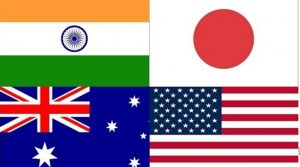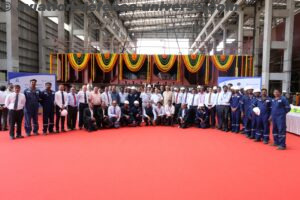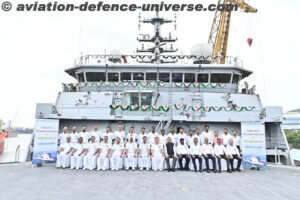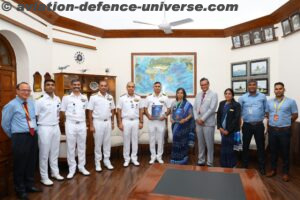
By Commodore AJ Singh, IN (Retd.)
New Delhi. 20 October 2020. In a long overdue and welcome development, India has invited Australia to participate in Exercise Malabar which is scheduled to be held in the Indian Ocean in November 2020 This has also been welcomed Down Under with the Australian Defence Minister Linda Reynolds said “High-end military exercises like MALABAR are key to enhancing Australia’s maritime capabilities, building interoperability with our close partners, and demonstrating our collective resolve to support an open and prosperous Indo-Pacific” and termed this an important milestone. Indeed, this will be the first time that all members of the Quad (Australia, India , Japan and the USA) will be participating in this exercise after 2007 when China had officially expressed its displeasure.
Malabar began as a bilateral India-US naval exercise in 1992 and has been a steady fixture since then with the scope and size increasing each year. Since 2007, Japan participated off and on till 2015, after which it has been a permanent participant. China has always viewed the Quad with suspicion as a grouping meant to contain China in the Indo-Pacific whereas the Quad members, except for the United States have been at pains to emphasise the inclusive nature of the Quad as a group committed to maintain a rules-based international order and a Free and Open Indo-Pacific without making a reference to any specific country.
The United States, on the other hand has rarely made any bones about its anti-China posture in the region which was further reinforced by the US National Security Strategy released in December 2017 which clearly classified China as a revisionist power. Infact, the strident US approach has been one of the major points of divergence in the Quad This has been clearly evident during the panel discussions amongst the military leadership of the Quad countries at successive Raisina Dialogues held in New Delhi. In March 2019, the Commander-in Chief of the US Indo-Pacific Command Admiral Phil Davidson at a press conference in Singapore stated that the ‘Quad’ may need to be shelved which was, in a way, a tacit acknowledgement of the divergent views amongst the Quad partners on certain fundamental issues.
India, for good reason had always been reticent about accepting the Quad as a military construct and successive Indian Naval Chiefs have been very guarded in communicating their views and have infact tried to distance themselves from any such suggestion. Unlike the other three countries who are resident Pacific powers and none of whom share a land border with China, India is the only Indian Ocean power amongst these and has its own bone to pick with China. over the long simmering border issue in the Himalayas. There is no doubt that China has been India’s biggest security threat for some time and as both nations develop their own versions of projecting power in the Indo-Pacific, and more specifically in the Indian Ocean , long simmering issues are bound to surface as the competition intensifies with confrontation and conflict becoming very real possibilities. India therefore has to adopt a very nuanced approach vis-à-vis China which may sometimes be at odds with the regional response east of the Malacca Straits.
However, the events of 2020 have brought about a distinct change in the Indian approach towards China. The Chinese transgression across the Line of Actual Control and the ongoing stand-off due to China’s obduracy in not restoring status quo ante is indicative of a much larger strategic design and intent. India too is standing its ground which has led to a hardening of its position on China.
In other parts of this region and the world too there has been a pushback against China’s behaviour, be it the spread of the Covid epidemic which originated in Wuhan, the belligerence over the maritime disputes in the South China Sea, the aggressive posturing over Taiwan, the ‘re-education’ of the people of Tibet and the Uighur Muslims . the arrogance over Hongkong or the issues over Huawei. This has endeared China to nobody and has actually led to a realisation of the danger that country represents in its ruthless approach towards furthering its global agenda with ‘Chinese characteristics’
This has also manifested itself in the Quad. Australia and Japan have sharpened their position on China. In July the US Secretary of State Mike Pompeo made an official statement on China which was the strongest to yet emanate from the US Government. That it enjoyed bipartisan support even in an election year reflects the level of concern in the US over Chia’s intentions.
Australia’s inclusion in Exercise Malabar was therefore inevitable and long overdue and perhaps accelerated by the recent Quad Foreign Ministers Meeting in Tokyo. From a purely military perspective, the conduct of Malabar in the eastern Indian Ocean will send a China a strong enough signal. Infact one could go so far as to suggest that the nature of the exercise should emphasise the multi-dimensional strengths of the Quad navies and should be aimed at highlighting the vulnerability of China’s Malacca Dilemma. That notwithstanding however, this exercise should not be interpreted either solely as an anti-China measure or as the only measure of the Quad’s credibility as a security construct. Suggestions that this could lead to the formation of a military alliance ( Asian NATO) would be self-defeating. While a ‘Security Dialogue’ cannot fully divorce itself from a military dimension, broader areas of areas of convergence could include aspects like Maritime Domain Awareness, information sharing, greater interoperability, logistic support etc. Areas such as cyber, space, AI, autonomous operations could be explored together.
The Quad has the potential to become a multi-sectoral and multi-dimensional regional construct which should form the nucleus of a larger architecture of like-minded nations committed to inclusive regional capacity building, addressing non-traditional natural and man-made security challenges, supporting Blue Economy Initiatives and strengthening multilateral institutional mechanisms.
The importance of the Indo-Pacific in a globalised and interconnected world characterised by trade dependencies and the movement of commerce has led even nations such as Germany (normally very Euro-centric) to articulate a 40 page Indo-Pacific strategy highlighting its commitment to a rules-based order and a ‘Free and Open Indo-Pacific.’ France, which already has a significant naval presence in the region and is seeking a larger role has taken the lead in appointing an Ambassador to the Indo-Pacific. The UK too has shown its intent and is likely to deploy one of its two aircraft carriers to this region. ASEAN’s centrality has been acknowledged and this vibrant group of nations can contribute significantly towards the economic well-being of the region.
India can and should take the lead in shaping the future of the Quad. It has established ‘comprehensive strategic partnerships’ with each of the other three and is engaging in 2+2 Meetings with the US and Japan with Australia soon to follow. Consolidating these bilateral relationships and strengthening the security network through foundational agreements on logistics , information sharing etc will greatly enhance India’s ability to retain its primacy and shape the geopolitical contours in the Indian Ocean.
The forthcoming Exercise Malabar should therefore be seen in a much larger context in terms of the strengthening of the Quad.
(Commodore Anil Jai Singh is a veteran submariner and the Vice President of the Indian Maritime Foundation. He is keenly interested in matters maritime and speaks and writes on the subject in India and abroad. The views expressed are open source and personal. He can be contacted on ajaisingh59@gmail.com )




























































































































